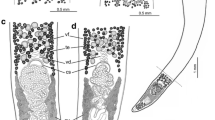Abstract
During a helminthological study of waterfowl in China, a new species (Cloacotaenia cygnimorbus sp. nov.) of hymenolepidid cestodes (tapeworm) was found in the small intestine of whooper swan (Cygnus cygnus, Linnaeus, 1758). The rudimentary rostellum and four unarmed muscular suckers, proglottids with distinct craspedote and three spherical testes were coincident with the characters of Cloacotaenia or Hymenolepis, but phylogenetic analysis of 28S rRNA and cox1 gene revealed that the new species is Cloacotaenia rather than Hymenolepis. Its morphology was also clearly differentiated from C. megalops in the arrangement of its testes in a triangle instead of in line and the cirrus unarmed rather than spined. Compared with C. megalops, the new species has more elongated neck, much larger mature proglottids and much smaller testes, cirrus sac, ovary, vitellarium and uterine proglottid. In addition, it infected the host intestine not the cloacae. Phylogenetic analysis of cox1 gene of the new species shows that it had a level of sequence variation (10.52–23.06%) with the sequences of C. megalops. The considerable morphological and molecular differences between those two parasites support C. cygnimorbus sp. nov. as a new species.



Similar content being viewed by others
Change history
06 October 2021
A Correction to this paper has been published: https://doi.org/10.1007/s11676-021-01399-5
References
Blaxter ML, De LP, Garey JR, Liu LX, Scheldeman P, Vierstraete A, Vanfleteren JR, Mackey LY, Dorris M, Frisse LM, Vida JT, Thomas WK (1998) A molecular evolutionary framework for the phylum nematoda. Nature 392:71–75
Blouin MS (2002) Molecular prospecting for cryptic species of nematodes: mitochondrial DNA versus internal transcribed spacer. Int J Parasitol 32:527–531
Caira JN, Jensen K (2017) Planetary biodiversity inventory (2008–2017): tapeworms from vertebrate bowels of the earth. Natural History Museum, Lawrence
Casanova JC, Santalla F, Durand P, Vaucher C, Feliu C, Renaud F (2001) Morphological and genetic differentiation of Rodentolepis straminea (Goeze, 1752) and Rodentolepis Microstoma (Dujardin, 1845) (Hymenolepididae). Parasitol Res 87:439–444
Czaplinski B, Vaucher C (1994) Family hymenolepididae ariola, 1899. In: Khalil LF, Jones A, Bray RA (eds) Keys to the cestode parasites of vertebrates. Commonwealth Agricultural Bureaux International, Cambridge, pp 595–663
Green AJ, Georgiev BB, Brochet AL, Gauthier-Clerc M, Fritz H, Guillemain M (2011) Determinants of the prevalence of the cloacal cestode Cloacotaenia megalops in teal wintering in the French Camargue. Eur J Wildl Res 57:275–281
Greiman SE, Tkach VV (2012) Description and phylogenetic relationships of Rodentolepis gnoskei n. sp. (Cyclophyllidea: Hymenolepididae) from a shrew Suncus varilla minor in Malawi. Parasitol Int 61:343–350
Guo A (2016) Characterization of the complete mitochondrial genome of the cloacal tapeworm Cloacotaenia megalops (Cestoda: Hymenolepididae). Parasites Vectors 9:490
Haukisalmi V, Hardman LM, Foronda P, Feliu C, Laakkonen J, Niemimaa J, Lehtonen JT, Henttonen H (2010) Systematic relationships of Hymenolepidid cestodes of rodents and shrews inferred from sequences of 28S ribosomal RNA. Zool Scr 39:631–641
Haukos DA, Neaville J (2003) Spatial and temporal changes in prevalence of a cloacal cestode in wintering waterfowl along the Gulf Coast of Texas. J Wildl Dis 39:152–160
Hu M, Chilton NB, Zhu X, Gasser RB (2002) Single-strand conformation polymorphism-based analysis of mitochondrial cytochrome c oxidase subunit 1 reveals significant substructuring in hookworm populations. Electrophoresis 23:27–34
Katoh K, Standley DM (2013) MAFFT multiple sequence alignment software version 7: improvements in performance and usability. Mol Biol Evol 30:772–780
Makarikov AA, Mel'nikova YA, Tkach VV (2015) Description and phylogenetic affinities of two new species of Nomadolepis (Eucestoda, Hymenolepididae) from Eastern Palearctic. Parasitol Int 64:453–463
Mariaux J (1998) A molecular phylogeny of the Eucestoda. J Parasitol 84:114–124
Moszczynska A, Locke SA, McLaughlin JD, Marcogliese DJ, Crease TJ (2009) Development of primers for the mitochondrial cytochrome c oxidase i gene in digenetic trematodes (Platyhelminthes) illustrates the challenge of barcoding parasitic helminths. Mol Ecol Resour 9(Suppl s1):75–82
Muniz-Pereira LC, Amato SB (1998) Fimbriaria fasciolaris and Cloacotaenia megalops (Eucestoda, Hymenolepididae), cestodes from Brazilian waterfowl. Mem Inst Oswaldo Cruz 93:767–772
Nowak MR, Krolaczyk K, Kavetska KM, Pilarczyk B (2011) Morphological features of Cloacotaenia megalops (Nitzsch in Creplin, 1829) (Cestoda, Hymenolepididae) from different hosts. Wiad Parazytol 57:31–36
Posada D, Crandall KA (1998) MODELTEST: testing the model of DNA substitution. Bioinformatics 14:817–818
Ronquist F, Huelsenbeck JP (2003) MrBayes 3: Bayesian phylogenetic inference under mixed models. Bioinformatics 19:1572–1574
Sharma S, Lyngdoh D, Roy B, Tandon V (2016) Differential diagnosis and molecular characterization of Hymenolepis nana and Hymenolepis diminuta (Cestoda: Cyclophyllidea: Hymenolepididae) based on nuclear rDNA ITS2 gene marker. Parasitol Res 115:4293–4298
Talavera G, Castresana J (2007) Improvement of phylogenies after removing divergent and ambiguously aligned blocks from protein sequence alignments. Syst Biol 56:564–577
Zehnder MP, Mariaux J (1999) Molecular systematic analysis of the order Proteocephalidea (Eucestoda) based on mitochondrial and nuclear rDNA sequences. Int J Parasitol 29:1841–1852
Acknowledgements
Thanks are especially due to Professor David Blair of the School of Marine and Tropical Biology, James Cook University, Professor Jean Mariaux, Natural History Museum in Geneva, Switzerland, and reviewers for assistance with the morphological description and language editing.
Author information
Authors and Affiliations
Corresponding author
Additional information
Publisher's Note
Springer Nature remains neutral with regard to jurisdictional claims in published maps and institutional affiliations.
Project funding: This study was supported by National Natural Science Foundation of China (Grant Nos. 31601873 and 31970501), Fundamental Research Funds for the Central Universities (No. 2572018BE07), and Surveillance of Wildlife Diseases from the State Forestry Administration of China.
The online version is available at http://www.springerlink.com
Corresponding editor: Yanbo Hu.
Rights and permissions
About this article
Cite this article
Hou, Z., Han, L., Sun, Y. et al. Morphological and phylogenetical analysis reveals that a new tapeworm species (Cestoda: Hymenolepididae) from whooper swan belongs to Cloacotaenia not Hymenolepis. J. For. Res. 31, 2581–2587 (2020). https://doi.org/10.1007/s11676-019-01036-2
Received:
Accepted:
Published:
Issue Date:
DOI: https://doi.org/10.1007/s11676-019-01036-2




